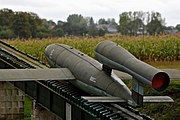| Michel Hollard | |
|---|---|
|
World War II portrait World War II portrait | |
| Born |
June 10, 1898 Épinay-sur-Seine, Eure, France |
| Died |
July 16, 1993 (aged 95) Ganges, Hérault, France |
| Place of burial | Gorniès, Hérault, France |
| Nationality |
|
| Education | Engineer |
| Occupation | French wartime resister |
| Organization | Réseau AGIR, French Resistance |
| Known for | Investigation of the V-1 flying bomb facilities in Northern France during World War II |
| Spouse(s) | Yvonne Gounelle |
| Children | Francine, Florian ( former conductor of the Orchestre symphonique de la région Centre) and Vincent |
| Parents |
Auguste Hollard Pauline Monod |
| Awards | |
| Website | |
| www.michel-hollard.com | |
Michel Hollard was a member of the French wartime resistance and engineer, who founded[1] the espionage group Réseau AGIR during World War II.
His contribution was recognised by the British by the award of the Distinguished Service Order for having "reconnoitered a number of heavily guarded V-1 sites and reported on them". Hollard's efforts included 49 trips smuggling reports to a British attaché in Switzerland.
Life[]
Initially serving in World War I, Hollard subsequently became an engineer[2] and was employed by Maison Gazogène Autobloc, a manufacturer of wood gas generators. Hollard founded AGIR in 1941.
Following his capture in February 1944, he was tortured and imprisoned first at Fresnes Prison and in June 1944 as a forced laborer at the main Neuengamme concentration camp (prisoner "F 33,948").[3] In 1945, as a result of Swedish intervention Hollard was one of a group of prisoners transferred to the ship Magdalena after being evacuated on April 20 on the prison ship Thielbek. The Thielbek was sunk on May 3 by a Royal Air Force attack on German shipping.

V-1 site no. 685, Val Ygot near Ardouval (Seine-Maritime, France); a V-1 on a reconstructed ramp torso.
After the war, Hollard "was given the rank of Colonel"[1][4] and, despite the V-1's destruction of over 80,000 English houses between June and September 1944, Sir Brian Horrocks called him "the man who literally saved London".[5]
A high-speed train that operates Eurostar's high-speed rail service between Britain, France and Belgium via the Channel Tunnel was named after him.[6]
References[]
- Citations
- ↑ 1.0 1.1 "Michel Hollard: Heros de la Resistance" (in French). http://www.michel-hollard.com. Retrieved 2010-02-09.
- ↑ "What happened to Michael Hollard, the man who saved London". TheAnswerBank.co.uk. 18 June 2001. http://www.theanswerbank.co.uk/History/article/what-happened-to-michael-hollard-the-man-who-saved-london/. Retrieved 2010-03-29.
- ↑ Florian Hollard (2005). "Michel Hollard: le Français qui a sauvé Londres" (in French). Le cherche midi. p. 214,.
- ↑ "Profile: WWII spy Michel Hollard". BBC.co.uk. 27 April 2004. http://news.bbc.co.uk/2/hi/europe/3663005.stm. Retrieved 2010-03-29.
- ↑ Lee, Bruce (2001) (Google Books). Marching orders: the untold story of World War II. p. 226. http://books.google.com/books?id=CAN54NcnjcMC&pg=PA226. Retrieved 2010-02-11.
- ↑ "Eurostar tribute to WWII hero". BBC News. 27 April 2004. http://news.bbc.co.uk/2/hi/uk_news/3662531.stm. Retrieved 8 July 2011.
- Bibliography
- Martelli, George (1961) [1960 Agent extraordinaire (French)]. The man who saved London: the story of Michel Hollard, D.S.O., Croix de Guerre. Odhams Press. http://openlibrary.org/b/OL14120028M/man_who_saved_London. Retrieved 2010-02-11.
- Hollard, Florian (2005). Michel Hollard: le Français qui a sauvé Londres (French). Le cherche midi. ISBN 978-2-7491-0387-7
External links[]
- Foot, M. R. D. (25 August 1993). "Obituary: Michel Hollard". The Independent. http://www.independent.co.uk/news/people/obituary-michel-hollard-1463220.html. Retrieved 8 July 2011.
The original article can be found at Michel Hollard and the edit history here.